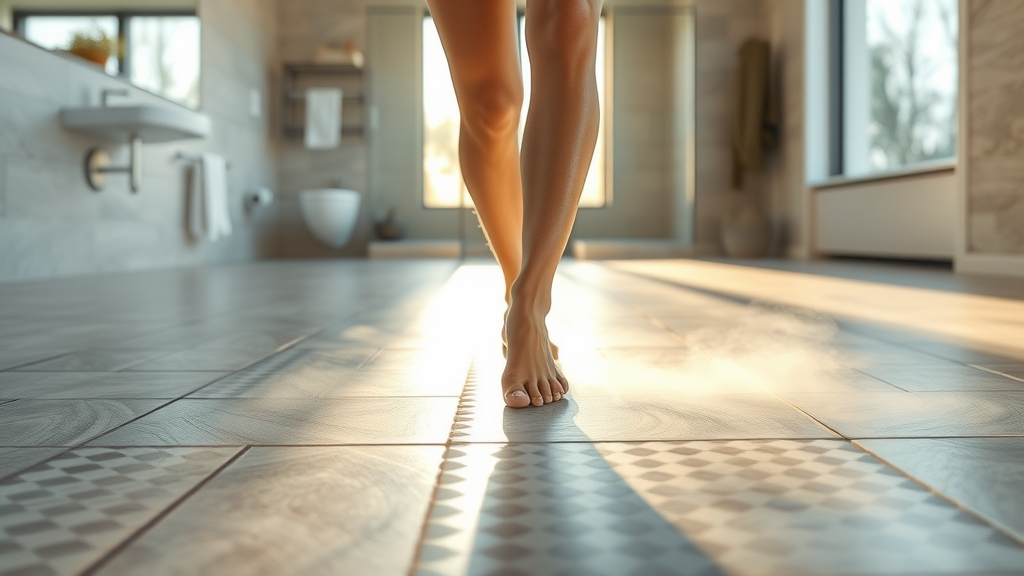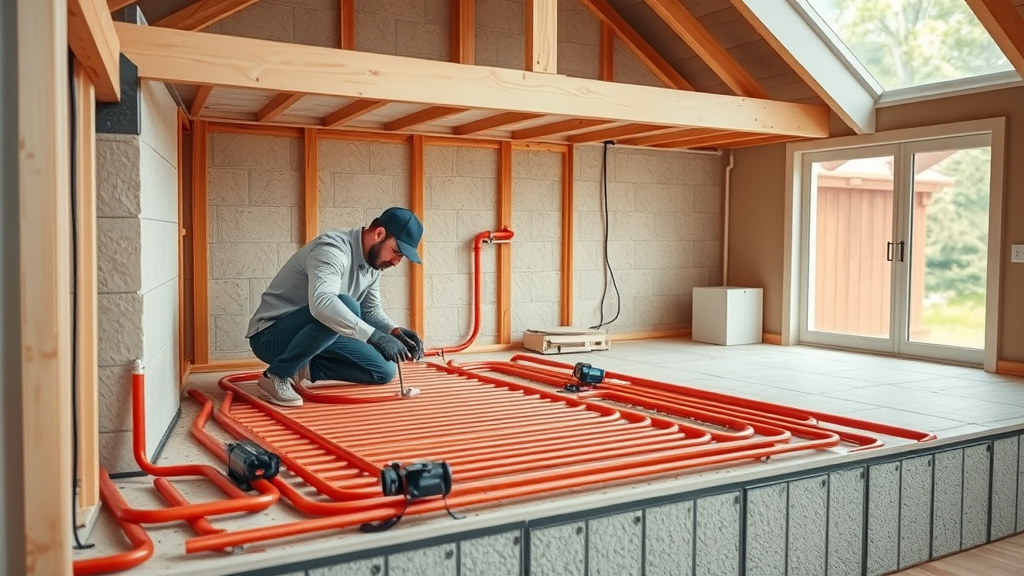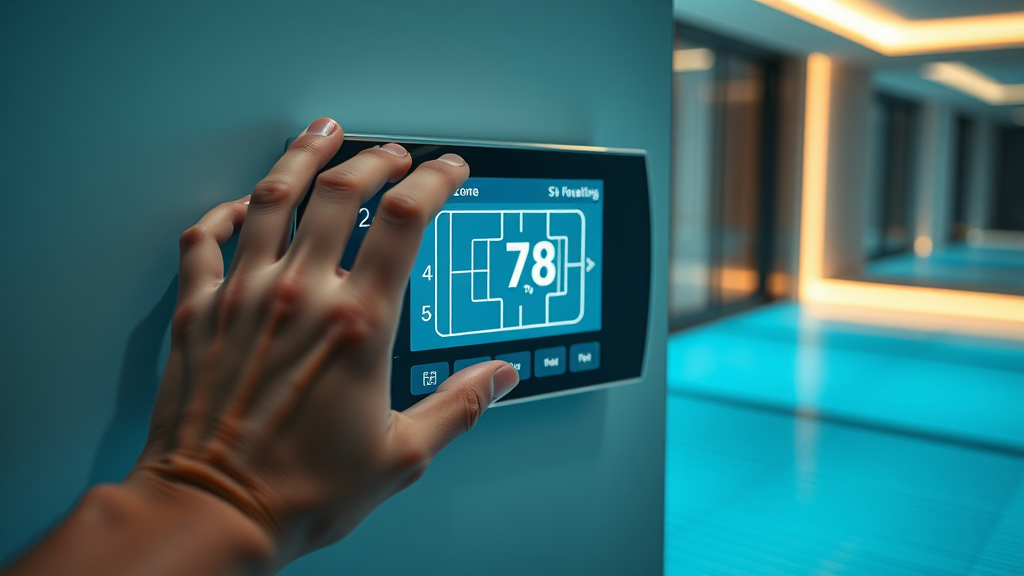Have you ever stepped out of bed on a chilly morning and wished your entire home felt as cozy underfoot as your favorite slippers? If so, you’re not alone. Many homeowners are rethinking traditional heating methods, searching for solutions that deliver more comfort, cleaner air, and better energy efficiency. Radiant floor heating benefits might just be the upgrade that completely changes how you feel about home warmth—forever. Ready to discover a smarter, quieter, and more comfortable way to heat your space? Let’s explore the features that make radiant floor heating the envy of every cold morning!
- What Are Radiant Floor Heating Benefits?
- Understanding Radiant Floor Heating: Systems Explained
- Top Radiant Floor Heating Benefits Homeowners Love
- Radiant Floor Heating vs. Other Heating Systems
- Installation Insights: Adopting Radiant Floor Heating Benefits
- Design Flexibility and Floor Heating Benefits
- Health and Well-being: Radiant Heat for Improved Indoor Air
- Smart Home Integration: Advanced Radiant Heating Systems
- Environmental Impact: Radiant Floor Energy Efficiency
- Real-World Results: Case Studies of Radiant Floor Heating Benefits
- Making the Most of Radiant Floor Heating Benefits: Maintenance and Reliability
- Cost Analysis: Is Radiant Floor Heating Worth It?
- People Also Ask about the Benefits and Downsides of Radiant Floor Heating
- Frequently Asked Questions About Radiant Floor Heating
- Expert Recommendations for Maximizing Your Radiant Floor Heating Benefits
- Key Takeaways: The Ultimate Guide to Radiant Floor Heating Benefits
- Ready to Experience Radiant Floor Heating Benefits?
- Videos
What Are Radiant Floor Heating Benefits?
"Have you ever wondered if there’s more to home warmth than clanking radiators or forced air vents? Discover how radiant floor heating benefits deliver the comfort and efficiency homeowners crave."
Radiant floor heating benefits go far beyond just toasty toes. Unlike traditional forced air systems that circulate warm air through vents or radiators that sit awkwardly along walls, radiant heat works by warming surfaces—and ultimately, every square foot of your room—from the ground up. The result? Even, consistent heat that feels more natural and pleasant throughout your living space, with none of the cold spots or harsh air blowing that come with older heating systems.
Beyond pure comfort, radiant floor heating brings new levels of energy efficiency and health benefits. Because the system works directly beneath the floor, there’s minimal heat loss as it bypasses ducts and vents. This means lower energy bills and a warmer house—even when the thermostat is set lower! Homeowners also rave about how radiant heat helps minimize airborne dust and allergens, improving indoor air quality for everyone.
Understanding Radiant Floor Heating: Systems Explained

Bright, spacious modern bathroom with a heated tile floor demonstrates the comfort and elegance of a radiant floor heating system.
How Does Radiant Floor Heat Work?
At its core, radiant floor heat works by gently warming either water pipes or electric cables installed beneath your flooring. As these pipes or cables heat up, warmth radiates upward through the surface—be it tile, stone, engineered wood, or even certain carpets—spreading steady, even heat across every square foot of your living space. Unlike forced air heating systems that blow warm air around (and stir up dust), radiant floor heating turns your entire floor into a gentle, low-temperature heat source, naturally rising and filling the room with comfort.
The warmth from beneath the floor means you’ll never experience the hot-cold cycles associated with traditional radiators or air heating. Each step on a heated floor feels luxuriously warm, and the effect persists even after the system turns off, thanks to the floor’s ability to hold and radiate warmth. Plus, without ducts, the dreaded “heat loss” from leaks or drafts is practically eliminated—making this system friendly on both your wallet and your sense of wellbeing.
Key Components of a Radiant Heating System
Every radiant heating system , whether electric radiant floor or hydronic radiant floor , features essential components that guarantee comfort and reliability. For hydronic systems , heated water is circulated through flexible pipes embedded under your floor. These pipes are often made of durable PEX tubing, which resists scaling and corrosion. Electric systems instead rely on heating cables or mats wired beneath the floor, delivering precise warmth where and when it’s needed most.
Both types of floor heating systems include high-quality insulation layers (to direct heat upward, not downward), programmable thermostats for energy efficiency, and control modules that ensure even temperatures room-by-room. Well-designed systems allow you to control comfort by the square foot , maximizing both flexibility and cost savings compared to antiquated “whole house” approaches. Maintenance is minimal, especially for electric radiant systems, and modern technology allows for easy adjustments and troubleshooting.
Types of Radiant Heating: Electric Radiant vs. Hydronic Systems
Radiant floor heating comes in two main styles: electric radiant floor and hydronic radiant floor . Electric systems use heating cables installed directly under finishes such as tile or vinyl. They’re especially popular in smaller spaces (like bathrooms or kitchens), are relatively quick to install, and work seamlessly with programmable thermostats for zone control. Hydronic radiant floors , on the other hand, circulate warm water (heated by a boiler or heat pump) through a labyrinth of pipes, delivering unmatched energy efficiency and comfort over larger areas—making them the gold standard for whole-home applications.
Each radiant heating system offers distinct advantages. Electric radiant floor heat shines where fast installation and precise room zoning are priorities, while hydronic radiant floor heating wins out in cost savings when heating large areas for long periods. We’ll compare their pros and cons head-to-head in the table below:
| Feature | Electric Radiant Floor Heating | Hydronic Radiant Floor Heating |
|---|---|---|
| Efficiency | Very efficient for small areas/quick response | Highly efficient for large areas/continuous use |
| Cost | Lower upfront; higher per-hour running cost (electricity) | Higher upfront; lower running cost (uses gas, boiler) |
| Installation | Simple for single rooms, minimal floor height increase | More complex; best for new builds or major renovations |
| Maintenance | Very low; primarily thermostat checks | Requires annual boiler checkups; pipes rarely need service |
| Best Use Cases | Bathrooms, kitchens, retrofits | Whole homes, large areas, new construction |
Top Radiant Floor Heating Benefits Homeowners Love
- Radiant floor heating provides even, consistent warmth across the room
- No more cold spots or drafty corners
- Silent operation compared to traditional heating systems
- Space-saving: no bulky radiators or vents
- Improved indoor air quality (less dust circulation vs. forced air)
- Efficient energy use = lower heating bills
- Flexibility for modern flooring

Inviting living room with people relaxing on a heated floor, showing the comfort and space-saving advantages of radiant floor heating.
Homeowners rave about heated floors for more than just toasty toes. They also love the way radiant floor heating eliminates cold drafts and noticeable temperature swings between rooms. With heat gently rising from below, every inch of your space feels inviting, allowing you to walk barefoot even on chilly winter days.
The benefits go further: silent operation means no more clanking radiators or noisy fans. Since radiant floors do not rely on air movement, you’ll notice less circulating dust and allergens—ideal for allergy sufferers or anyone worried about indoor air quality. Getting back valuable square footage (no radiators or baseboard heaters!) opens up your space to more flexible, modern design and furniture arrangements. Finally, the system’s fine-tuned efficiency generally means lower energy bills every month—a win for both your budget and the planet.
Radiant Floor Heating vs. Other Heating Systems
Comparing Floor Heating Systems: Which Offers the Most Comfort?

Split-room scene comparing how warmth is distributed in typical radiator/air systems versus floor heating—highlighting the comfort and efficiency of radiant floors.
When considering the comfort level of a home, radiant floor heating systems consistently score higher than traditional forced air systems or baseboard units. While radiators create hot and cold zones and forced air brings drafts and noise, floor heat provides an even, gentle warmth where it’s needed most—underfoot and throughout the entire room. Instead of the usual head-in-the-heat, feet-in-the-cold effect you get with air heat, you enjoy consistent temperatures from the floor up, creating a natural, cozy environment for everyone.
Comparatively, radiant heat eliminates many of the annoyances of air heating systems, like dust circulation, loud cycling noises, and chilly corners. The differences become even more pronounced in open-plan homes or rooms with large windows, where conventional heating systems struggle to battle drafts. Radiant floors deliver warmth exactly where you want it, making chilly spots a thing of the past.
| Feature | Radiant Floor Heating | Forced Air | Baseboard |
|---|---|---|---|
| Heat Distribution | Even, from the floor up | Uneven, rises quickly to ceiling | Localized near units |
| Noise Level | Silent | Noisy (fans/blowers) | Silent |
| Air Quality | Improved, less dust/allergens | Dust circulates, dry air | Little circulation |
| Energy Efficiency | High | Moderate | Moderate |
| Space Requirements | None (invisible) | Vents/ducts | Bulky baseboards |
Energy Efficiency: How Radiant Floor Heat Reduces Costs
"Radiant floor heating lets you control comfort by the square foot, maximizing efficiency and savings."
One of the standout radiant floor heating benefits is energy efficiency . With radiant heating systems , warmth flows directly into your living space from beneath, minimizing heat loss common with forced air heating systems where energy escapes through leaky ducts or drafty vents. Because floors hold and radiate heat naturally, you can keep your thermostat set lower while still feeling warmer—which means lower heating bills over the course of the season.
Smart thermostats and zoning options allow homeowners to heat only the rooms they use, avoiding the waste of heating unused areas. This targeted approach gives you full control and savings, along with more even comfort throughout your home. For those with green energy ambitions, pairing radiant heat with solar panels or high-efficiency heat pumps further slashes a home’s environmental impact and utility costs.
Installation Insights: Adopting Radiant Floor Heating Benefits
Is Retrofitting Existing Homes with Radiant Floors Possible?
- Factors influencing installation costs

Technicians installing radiant heating pipes beneath a subfloor, showcasing the careful installation process for maximum efficiency.
- Timeframe for radiant heating system installation
Many homeowners wonder if it’s possible to retrofit radiant floor heat in an existing house—and the answer is yes, in most cases! Electric radiant floor heating mats can often be added above subfloors and beneath new tile or engineered wood surfaces with minimal floor height increase. Hydronic radiant systems are easier to install during renovations or new builds, but experienced contractors can often retrofit them, especially in larger rooms with accessible subfloors.
Factors like overall square footage, existing floor coverings, and the complexity of a room’s design all impact installation timeframes and cost. Homeowners should also factor in the value of long-term savings on energy bills and the increased resale appeal that radiant heat brings.
Best Floor Coverings for Heated Floors
The ideal floor coverings for radiant floor heating systems are those that conduct and retain heat well—think ceramic tile, stone, and engineered wood. These materials let warmth rise efficiently to the room above. Carpeting can also work, provided it’s not too thick or insulated. Vinyl, laminate, and some linoleum products are compatible as technology advances, but always double-check manufacturer guidelines for best results.
Today’s floor heating system technology makes it possible to enjoy heated floors in nearly every space, including bathrooms, kitchens, bedrooms, basements, and even sunrooms. Matching the correct covering to your system guarantees optimal comfort and energy efficiency day after day.
Design Flexibility and Floor Heating Benefits
Radiant Floor Heat Is Invisible: Designing Without Bulk Radiators
One of the most exciting radiant floor heating benefits is complete freedom in interior design. Since radiant floors are hidden beneath the surface, you reclaim every last inch of floor and wall space for open layouts, large windows, and innovative décor choices. Gone are the days of arranging furniture around clunky radiators or baseboard units! This allows for minimalist, modern spaces that feel bigger and look cleaner.
Whether you dream of an airy open-plan loft or a serene bathroom spa, radiant heating systems give you the invisibility and flexibility to design any room, your way—without compromise.
Radiant Floor Installation Options for Any Room

Elegant interior with no visible radiators—showcasing the design freedom made possible by radiant floor heating.
From bathrooms where cold tiles are a thing of the past to basements, bedrooms, and even garages, radiant floor installation can be customized for almost any space. Innovative radiant heating systems adapt to both concrete slab and suspended wood frame construction, making them suitable for both new builds and remodels. The result? Luxury and comfort underfoot, wherever you want it.
Homeowners appreciate how heated floors open up their design possibilities, whether they want a sleek modern home, rustic cabin, or energy-efficient passive structure. The seamless integration means no more intrusive heating elements—just warmth, right where you need it.
Health and Well-being: Radiant Heat for Improved Indoor Air
Reduced Dust and Allergens with Radiant Floor Heat
- How radiant floor heating improves respiratory health
The gentle, radiative nature of radiant floor heat creates a healthier indoor environment by drastically reducing airborne dust, allergens, and even pet dander. Because radiant heating doesn’t rely on forced airflow, it doesn’t stir up particles like traditional systems. This is a huge perk for allergy and asthma sufferers, families with small children, and anyone sensitive to changes in air quality.
By eliminating the constant “blowing” of air heating systems , radiant floors help maintain better humidity, fewer contaminants in motion, and less overall irritation of eyes or respiratory passages. The entire living space feels fresher, cleaner, and more comfortable on every level, supporting both short- and long-term well-being.
Silent Comfort: The Psychological Benefits of Heated Floors

Relaxed, peaceful bedroom atmosphere, clean air, and spa-like comfort—core advantages of radiant floor heating for health and wellness.
Comfort goes beyond temperature with heated floors . The absence of rattling radiators and the hush of even warmth from below create a tranquil, spa-like ambiance inside your home. This silent comfort supports peace of mind, better sleep, and reduces the stress typically triggered by clattering pipes or sudden blasts of hot or cold air.
The psychological effect of a cozy, quiet, and evenly heated home environment fosters relaxation, allowing everyone—from kids to adults—to rest easy and enjoy the space more fully. Heated floors make cold mornings friendlier and chilly nights a distant memory.
Smart Home Integration: Advanced Radiant Heating Systems
Programmability and Zone Control with Radiant Heating
- Smart thermostats for energy efficiency
- Remote control of radiant heating systems

Hand adjusting a smart thermostat—illustrating zone controls for radiant floor heating and efficient energy management.
Today’s radiant floor heating systems are more intelligent and adaptable than ever. Smart thermostats let users program and monitor heating zones remotely—by room, by floor, or by entire home. Want to come home to a perfectly heated bathroom but save on energy in unused areas? Programmable timers, wifi connectivity, and intuitive mobile apps make it a breeze, maximizing both comfort and efficiency.
This degree of zone control ensures you only use energy (and pay for) the warmth you truly need, slashing utility bills while enjoying a perfectly tailored environment. The latest tech even integrates with voice assistants and home automation systems for total convenience and peace of mind.
Environmental Impact: Radiant Floor Energy Efficiency
Reduced Carbon Footprint with Efficient Floor Heating

Eco-friendly home with radiant floor heating system, highlighting reduced carbon emissions and renewable energy options.
Radiant floor heating benefits aren’t just good for your family—they’re good for the planet. Because these systems minimize energy loss and work best at lower, more even temperatures, they consume less fuel over time compared to conventional air heating systems . This helps households reduce their carbon footprint and utility bills simultaneously.
Paired with green technologies like solar PV or geothermal heat pumps, hydronic radiant heating can further reduce reliance on fossil fuels. The result: a cleaner, greener, and more sustainable way to keep your family warm all winter long.
Leveraging Renewable Energy Sources for Radiant Floor Heating
Radiant floor heating systems—especially hydronic radiant floor heating —are uniquely situated to take advantage of renewable energy sources. You can connect a solar water heater, ground-source (geothermal) heat pump, or even clean-burning biomass boiler to provide hot water for your hydronic system. This drives operational costs even lower and puts your home on the cutting edge of energy technology.
By investing in radiant floor heat , you position your home for long-term cost savings and environmental responsibility without sacrificing any comfort along the way.
Real-World Results: Case Studies of Radiant Floor Heating Benefits
"Our switch to radiant flooring cut our energy bills by 25% and dramatically improved comfort in every season." — Homeowner testimonial
| Metric | Traditional Forced Air | Radiant Floor Heating |
|---|---|---|
| Average Annual Energy Cost | $1,800 | $1,350 |
| Comfort Score (1–10) | 6 | 9 |
| Air Quality Rating | Fair | Excellent |
| Noise Level | Moderate/High | Silent |

Family celebrating energy savings and year-round comfort—real-world proof that switching to radiant floors transforms home life.
Homeowners who switch to radiant floor heating consistently report lower heating costs, more reliable comfort, and a dramatic improvement in air quality. With a system tailored to each square foot of living space, families enjoy the luxury of warm floors, fresher air, and quieter rooms without the headaches of drafty vents or overbearing radiators.
Making the Most of Radiant Floor Heating Benefits: Maintenance and Reliability
How Reliable Are Radiant Heat Systems?
Radiant heat systems are among the most reliable heating solutions on the market. With fewer moving parts than forced air or baseboard systems, there’s less to break or require servicing over time. Electric radiant floors can last 20 years or more with minimal maintenance; hydronic systems have a similar lifespan when properly installed and paired with quality boilers or heat sources.
The risk of leaks in hydronic systems is extremely low thanks to advances in tubing and joinery. For extra peace of mind, many modern systems include sensors and monitors to detect any issues early, reducing downtime and preventively addressing potential problems.
Easy Maintenance Tips for Heated Floors

Organized utility room with radiant floor control manifold, illustrating simple periodic checks for optimal performance.
Maintaining your radiant floor heating system is refreshingly simple. For electric systems, occasional thermostat checks and scheduled inspections by a professional will keep everything running smoothly. For hydronic radiant floors, an annual boiler check (and occasional inspection of the manifold or pump) is usually all that’s needed. Keeping your floor coverings clean and free from damage will maximize heat transfer and preserve long-term comfort.
Choosing well-reviewed installers and trusted brands is the first step toward a virtually worry-free experience. Most radiant heating systems are practically set-and-forget—so you can enjoy quiet, even warmth year after year.
Cost Analysis: Is Radiant Floor Heating Worth It?
| Type | Radiant Floor Heating | Forced Air | Baseboard |
|---|---|---|---|
| Installation (per sq. ft.) | $10 – $20 | $8 – $16 | $6 – $12 |
| Annual Operating Cost | Low (high efficiency) | Moderate (duct losses) | Moderate |
| Maintenance | Minimal | Regular service, filter changes | Occasional |
| Lifespan | 20+ years | 15–20 years | 15–20 years |
Calculating Long-term Savings with Radiant Floor Systems
While radiant floor heating systems sometimes cost more to install upfront compared to traditional forced air or baseboard systems, the long-term savings can be significant. Lower energy usage, decreased maintenance costs, and the system’s long lifespan all add up to major value. Factor in the added comfort, healthier air, and increased property value, and it’s clear why so many families make the switch. In many scenarios, payback is achieved within several years, especially in climates with long heating seasons.
Because radiant floor heat is so efficient and lasts for decades, homeowners enjoy both immediate comfort and a solid return on investment over time.
People Also Ask about the Benefits and Downsides of Radiant Floor Heating
What is the downside of radiant heat?
- Higher upfront installation cost
- Longer installation period in some cases
- Potential for floor height increase
- May require professional repair for leaks (hydronic)
Is radiant floor heating worth the cost?
- Yes, for many homeowners radiant floor heating provides unmatched comfort, energy savings, and even heat—often justifying the initial investment over time.
What is the downside of underfloor heating?
- Low-quality installation can lead to inefficiency
- Not always suitable for all types of flooring
What are the disadvantages of radiant energy?
- Not efficient for rapid heating
- Upfront investment may not suit temporary living situations
Frequently Asked Questions About Radiant Floor Heating
-
Can I install radiant floor heating in an existing home?
Yes, many electric and hydronic systems can retrofit into existing homes—especially during remodeling projects. Expert advice helps assess options and plan installation for best results. -
What floors are best for radiant floor heating?
Stone, tile, and engineered wood conduct heat best, but thin carpet, laminate, and luxury vinyl can also be compatible. Confirm all flooring choices with your installer to guarantee optimal performance. -
How long do radiant floor heating systems last?
When properly installed and maintained, most systems will last 20 years or more, with hydronic tubing sometimes exceeding 40 years. -
Can radiant floor heat replace central heating?
Absolutely—many homes use radiant heat as the sole heating source. For larger homes or older structures, a hybrid setup with supplemental central heating may be recommended for extreme weather.
Expert Recommendations for Maximizing Your Radiant Floor Heating Benefits
- Steps to optimize system settings for maximum savings
- Routine checks and professional servicing tips
- Using zoning and insulation for even higher energy efficiency
Key Takeaways: The Ultimate Guide to Radiant Floor Heating Benefits
- Radiant floor heating benefits include comfort, efficiency, and improved air quality
- Both electric radiant and hydronic radiant floor systems offer different advantages
- A radiant heating system is a future-proof investment for many homes
Ready to Experience Radiant Floor Heating Benefits?
- For expert help or advice visit Peak Underfloor Heating at https://peakunderfloorheating.com/
Take action: Explore radiant floor heating for unmatched comfort, lower bills, and a healthier home. Consult experts for a custom solution that delivers lasting results!
Sources
- U.S. Department of Energy – https://energy.gov
- Peak Underfloor Heating – https://peakunderfloorheating.com/
- Green Building Advisor – https://greenbuildingadvisor.com
Radiant floor heating offers numerous advantages that can significantly enhance your home’s comfort and efficiency. For a comprehensive understanding of these benefits, consider exploring the following resources:
-
“5 Benefits of Radiant Floor Heating” ( climatecontrolcompany.com )
-
“5 Benefits Radiant Floor Heating Can Bring to Your Home” ( meadowlarkbuilders.com )
These articles provide in-depth insights into how radiant floor heating can improve your living environment.
 Add Row
Add Row  Add
Add 









Write A Comment